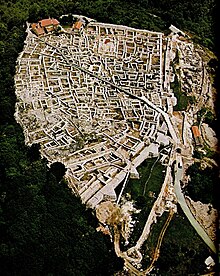Shumen fortress
The Shumen Fortress ( Bulgarian Шуменска крепост ), or Star grad (Bulgarian Стар град, to German Old City) is a medieval fortress above the Bulgarian city of Shumen and an important cultural monument of the region.
The fortress was the main defense system of Schumen in the Middle Ages and one of the most important fortresses in northeastern Bulgaria and now houses a museum. They are listed among the 100 national tourist objects of Bulgaria (number 94) created by the Bulgarian Tourist Association .
location
The fortress was built on the Shumen Plateau , which is located directly next to the city of Shumen, at a height of 405 m. The facility is located around 3 km west of the modern city on the eastern part of the plateau. The ridge of the plateau extends to the west of the fortress. For this reason the main gate was built here. On the other side, the fortress is built on rocks that form the edge of the plateau like a gorge. From the fortress you can see the Madara fortress to the east and the Pliska fortress to the northwest .
history
The first fortress was built by the Thracians . They were followed by the Romans and Byzantines . In the First Bulgarian Empire (679-1018) the fortress was neglected, as the heavily fortified Bulgarian capitals Pliska and Preslaw were nearby .
During the Second Bulgarian Empire (1018-1386) the fortress flourished. The former capitals were either ruins (preslaw) or no longer played an important regional role. The natural protection provided by the plateau strengthened the strategic position of the fortress in defending against the Mongol storm .
During the reign of Ivan Alexander and Ivan Schischman in the 14th century, the fortress was surrounded by three belts of fortifications. Two of them, which protected the inner city, were uncovered after archaeological excavations. The inner city was densely populated. In it were six churches and in the western part of the governor's palace, which was converted into a donjon (defense tower).
In 1388 the city was taken by the Ottomans, led by Vizier Ali Pascha. They used the existing facility until 1444 when the crusaders of Władysław von Varna took and destroyed the city.
present
Today the ruins of the fortress are among the best-studied in the country. Excavations were carried out in 1957–1987, with the most active excavations taking place between 1974 and 1981. Three fortress walls were discovered: a Roman, a Byzantine (which was used during the First Bulgarian Empire and the Ottomans ) and a Bulgarian from the time of the Second Bulgarian Empire . The last wall was built in the style of the Tarnow architecture school .
During the excavations, the foundations of an early Byzantine bath, two reservoirs, 12 churches, a monastery complex and a citadel were uncovered. The following were also found:
- the Shumen inscription by Tsar Ivan Shishman , in which the city is recorded for the first time under the name Shumen
- the table of a dancing man
- an inscription in Cyrillic “Остро [...] богоин” , which some researchers consider to be the oldest memorial written in Cyrillic
- Sgraffito ceramic
- Typical Troy ceramics, which as an indication of trade relations with the city on the Dardanelles is considered
- liturgical gold vessels
- as well as a large number of coins from all eras
The total area of the fortress is over 32,000 m². The excavation revealed that a significant part of the population lived outside the fortress walls in a suburb.
In September 2010 it was announced that Norway and the municipality of Shumen are providing funding for the conservation and restoration of the southern and eastern fortress walls. This is the second major project, after the excavations on the island of Sweti Iwan , that Norway is co-financing in Bulgaria.
Individual evidence
- ↑ Норвегия финансира реставрация на шуменската крепост , mediapool.bg, September 20, 2010
literature
- W. Antonowa: Шумен и Шуменската крепост (to German Shumen and the Shumen fortress), Shumen 1997.
Web links
- The Shumen Fortress Museum
- Shumen fortress on the site of archaeologist Jawor Wasilew
Coordinates: 43 ° 15 ′ 45.4 " N , 26 ° 53 ′ 40.7" E
